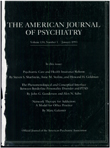Hidden severe psychiatric morbidity in sentenced prisoners: an Australian study
Abstract
OBJECTIVE: The aim of this survey was to estimate the prevalence of severe mental disorders in a representative sample of sentenced prisoners. METHOD: The subjects were selected as a random sample of sentenced prisoners in Melbourne's three metropolitan prisons. Interviews were conducted with 158 men and 31 women. Clinicians used the Structured Clinical Interview for DSM-III-R (SCID) to diagnose psychotic, affective, and substance use disorders. RESULTS: Six prisoners (3%) received current diagnoses of psychotic disorders, and 23 (12%) were diagnosed as having current mood disorders, mainly major depression. A lifetime diagnosis of at least one mental disorder each was made for 82% of the respondents, and in 26% more than one lifetime disorder was diagnosed. Sixty-nine percent received lifetime diagnoses of dependence on or abuse of alcohol, other psychoactive substances, or a combination of these. CONCLUSIONS: These findings do not indicate a large-scale shift of deinstitutionalized psychotically ill people from mental hospitals to prisons. They do, however, highlight the diversion into the corrections system of substance-dependent people and the apparent pool of prisoners with largely untreated major depression.
Access content
To read the fulltext, please use one of the options below to sign in or purchase access.- Personal login
- Institutional Login
- Sign in via OpenAthens
- Register for access
-
Please login/register if you wish to pair your device and check access availability.
Not a subscriber?
PsychiatryOnline subscription options offer access to the DSM-5 library, books, journals, CME, and patient resources. This all-in-one virtual library provides psychiatrists and mental health professionals with key resources for diagnosis, treatment, research, and professional development.
Need more help? PsychiatryOnline Customer Service may be reached by emailing [email protected] or by calling 800-368-5777 (in the U.S.) or 703-907-7322 (outside the U.S.).



